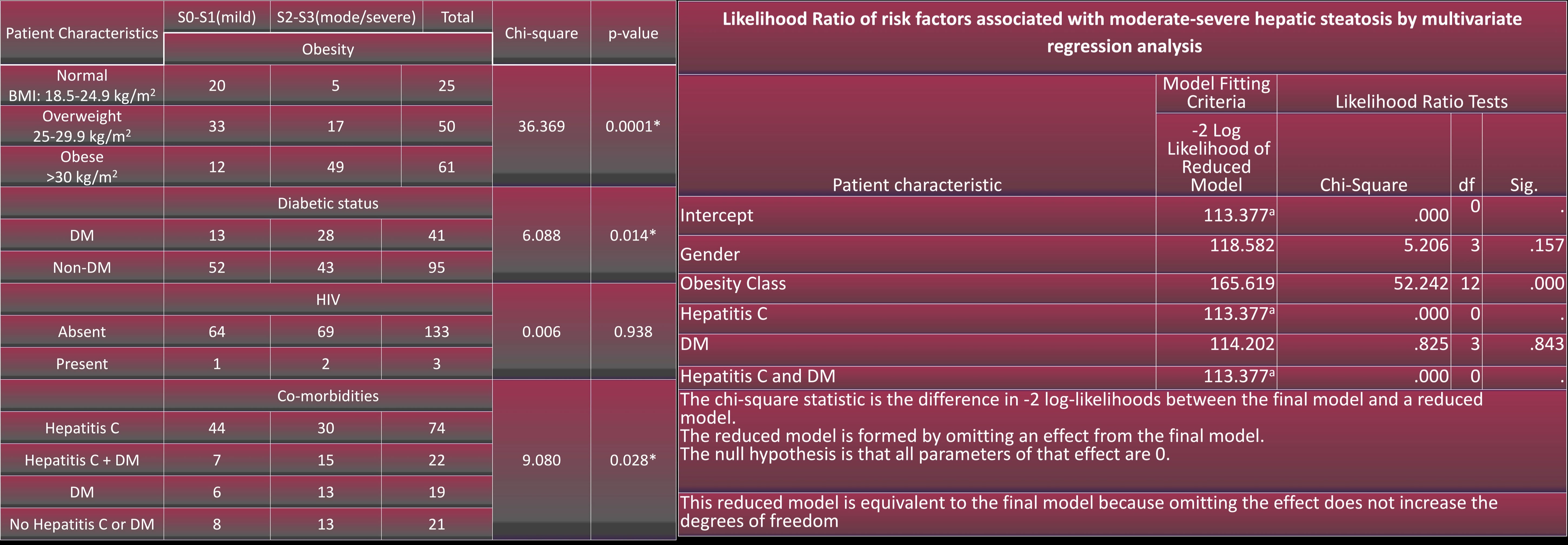Back


Poster Session C - Monday Afternoon
Category: Liver
C0523 - Assessment of Risk Factors of Hepatic Steatosis Diagnosed by Vibration Controlled Transient Elastography (VCTE) in Chronic Hepatitis C Virus Infected Patients
Monday, October 24, 2022
3:00 PM – 5:00 PM ET
Location: Crown Ballroom

Has Audio

Yuvaraj Singh, MD
St. Vincent Hospital
Worcester, MA
Presenting Author(s)
Yuvaraj Singh, MD, Maya Gogtay, MD, Susant Gurung, MD, Mithil Gowda Suresh, MD, Nitin Trivedi, MD, George M. Abraham, MD, MPH
Saint Vincent Hospital, Worcester, MA
Introduction: In chronic hepatitis C patients, the prevalence of steatosis ranges from 40% to 86%. Our aim was to study the risk factors of moderate/severe hepatic steatosis diagnosed by vibration-controlled transient elastography (VCTE) in these patients.
Methods: This retrospective cross-sectional study included a cohort of 158 adult patients with suspected nonalcoholic fatty liver disease (NAFLD) evaluated in the clinic. Patients with significant alcohol consumption, oral contraceptive use, hepatitis B, autoimmune hepatitis, and primary biliary cirrhosis were excluded. Steatosis was categorized as S0-S1 (mild) and S2-S3 (moderate/severe) based on the controlled attenuation parameter (CAP) grade. Continuous variables were assessed using an unpaired t-test and categorical variables using chi-Square with p< 0.05 were considered statistically significant. A multinominal logistic regression analysis was done to study the relationship between the CAP grade (dependent variable) and significant covariates (independent variables) while controlling for the effect of each other. The model fitting criteria used was -2 log-likelihood (LL) which was tested for goodness-of-fit and pseudo R2 showed a Negelkerke value of 0.520.
Results: 136 patients met inclusion criteria. A moderate/severe steatosis score was associated with various risk factors: obesity (p< 0.05), DM (p< 0.014), metformin use (p< 0.0017), fibrosis (p< 0.009). A 4x2 chi-square table showed 40% of patients with hepatitis C, 68% with hepatitis C + DM, 68% with DM, and 61% non-hepatitis C, non-DM patients (p-0.028) had moderate to severe hepatic steatosis. On regression analysis, the -2 LL of the reduced model in patients with hepatitis C and hepatitis C + DM revealed that omitting the effect of obesity resulted in zero degrees of freedom (df 0). Obesity had a significant association with steatosis (chi-square value 52, df 12). DM had a weak association with steatosis (chi-square value 0.825, df 3).
Discussion: Hepatic steatosis is independently associated with metabolic parameters like obesity and DM. The chi-square analysis initially indicated that hepatitis C is associated with steatosis, but using multivariate analysis, we accounted for potential confounders, i.e., the most significant risk factor for steatosis in untreated hepatitis C patients is their BMI. Thus, the management of obesity in patients with chronic hepatitis C may be necessary for reducing the risk of steatosis progression and improving their fibrosis score.

Disclosures:
Yuvaraj Singh, MD, Maya Gogtay, MD, Susant Gurung, MD, Mithil Gowda Suresh, MD, Nitin Trivedi, MD, George M. Abraham, MD, MPH. C0523 - Assessment of Risk Factors of Hepatic Steatosis Diagnosed by Vibration Controlled Transient Elastography (VCTE) in Chronic Hepatitis C Virus Infected Patients, ACG 2022 Annual Scientific Meeting Abstracts. Charlotte, NC: American College of Gastroenterology.
Saint Vincent Hospital, Worcester, MA
Introduction: In chronic hepatitis C patients, the prevalence of steatosis ranges from 40% to 86%. Our aim was to study the risk factors of moderate/severe hepatic steatosis diagnosed by vibration-controlled transient elastography (VCTE) in these patients.
Methods: This retrospective cross-sectional study included a cohort of 158 adult patients with suspected nonalcoholic fatty liver disease (NAFLD) evaluated in the clinic. Patients with significant alcohol consumption, oral contraceptive use, hepatitis B, autoimmune hepatitis, and primary biliary cirrhosis were excluded. Steatosis was categorized as S0-S1 (mild) and S2-S3 (moderate/severe) based on the controlled attenuation parameter (CAP) grade. Continuous variables were assessed using an unpaired t-test and categorical variables using chi-Square with p< 0.05 were considered statistically significant. A multinominal logistic regression analysis was done to study the relationship between the CAP grade (dependent variable) and significant covariates (independent variables) while controlling for the effect of each other. The model fitting criteria used was -2 log-likelihood (LL) which was tested for goodness-of-fit and pseudo R2 showed a Negelkerke value of 0.520.
Results: 136 patients met inclusion criteria. A moderate/severe steatosis score was associated with various risk factors: obesity (p< 0.05), DM (p< 0.014), metformin use (p< 0.0017), fibrosis (p< 0.009). A 4x2 chi-square table showed 40% of patients with hepatitis C, 68% with hepatitis C + DM, 68% with DM, and 61% non-hepatitis C, non-DM patients (p-0.028) had moderate to severe hepatic steatosis. On regression analysis, the -2 LL of the reduced model in patients with hepatitis C and hepatitis C + DM revealed that omitting the effect of obesity resulted in zero degrees of freedom (df 0). Obesity had a significant association with steatosis (chi-square value 52, df 12). DM had a weak association with steatosis (chi-square value 0.825, df 3).
Discussion: Hepatic steatosis is independently associated with metabolic parameters like obesity and DM. The chi-square analysis initially indicated that hepatitis C is associated with steatosis, but using multivariate analysis, we accounted for potential confounders, i.e., the most significant risk factor for steatosis in untreated hepatitis C patients is their BMI. Thus, the management of obesity in patients with chronic hepatitis C may be necessary for reducing the risk of steatosis progression and improving their fibrosis score.

Figure: Results of patient characteristics and multivariate regression analysis
Disclosures:
Yuvaraj Singh indicated no relevant financial relationships.
Maya Gogtay indicated no relevant financial relationships.
Susant Gurung indicated no relevant financial relationships.
Mithil Gowda Suresh indicated no relevant financial relationships.
Nitin Trivedi indicated no relevant financial relationships.
George Abraham indicated no relevant financial relationships.
Yuvaraj Singh, MD, Maya Gogtay, MD, Susant Gurung, MD, Mithil Gowda Suresh, MD, Nitin Trivedi, MD, George M. Abraham, MD, MPH. C0523 - Assessment of Risk Factors of Hepatic Steatosis Diagnosed by Vibration Controlled Transient Elastography (VCTE) in Chronic Hepatitis C Virus Infected Patients, ACG 2022 Annual Scientific Meeting Abstracts. Charlotte, NC: American College of Gastroenterology.
